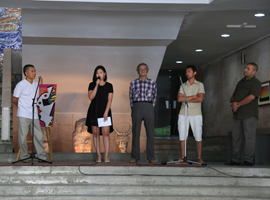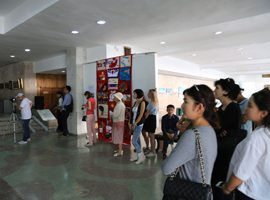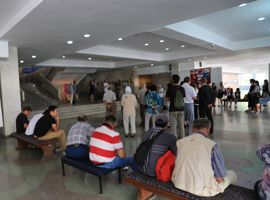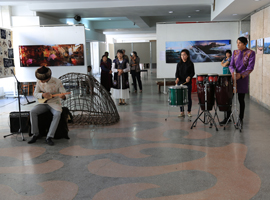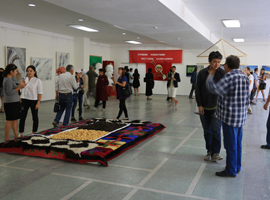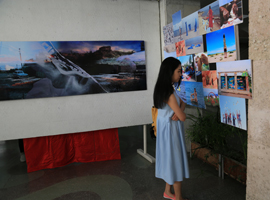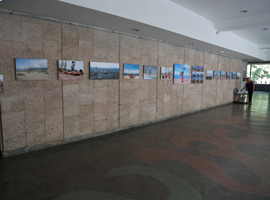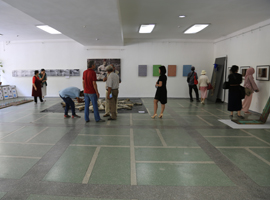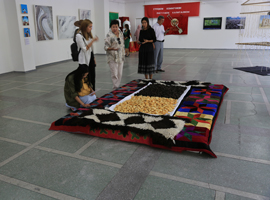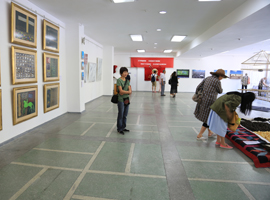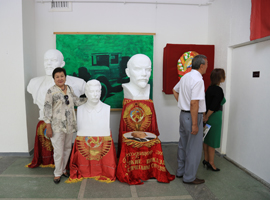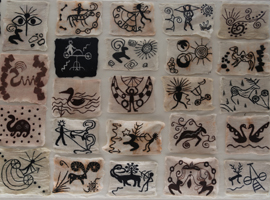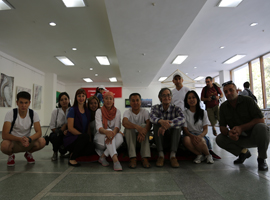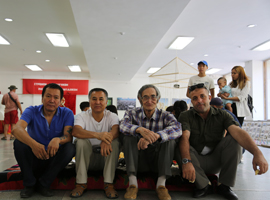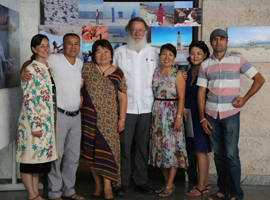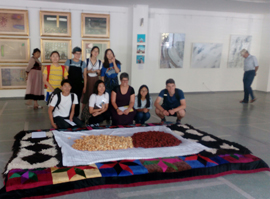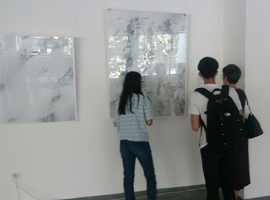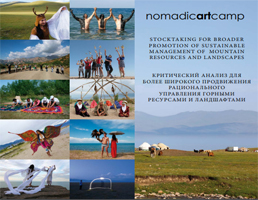2017 NOMADIC ART CAMP
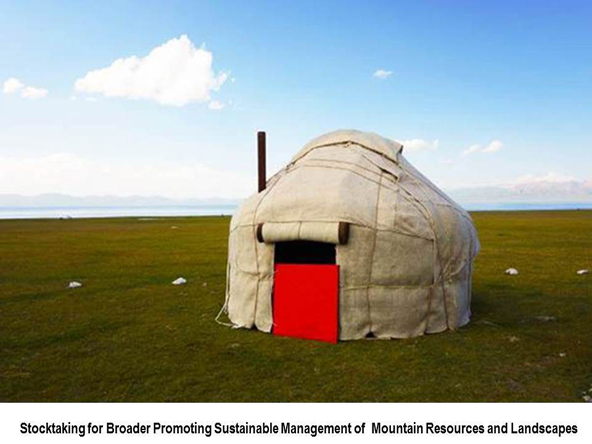
Nomadic Art Camp 2017: Stocktaking for Broader Promotion of Sustainable Management of Mountain Resources and Landscapes
The Nomadic Art Camp, a seven-year initiative held along the shores of three iconic mountain lakes in Kyrgyzstan—Issyk-Kul, Sary-Chelek, and Son-Kul—beautifully merges contemporary art with ecological awareness. This dynamic platform brings together artists and creative thinkers to engage with critical issues such as biodiversity conservation, cultural heritage, identity, and the complex relationship between humans and nature. Positioned at the intersection of art, ecology, and social responsibility, the Nomadic Art Camp offers a profound exploration of eco-consciousness. Surrounded by awe-inspiring landscapes, participating artists not only reflect on the environmental challenges facing these regions but also actively engage with nature through their artistic practices.
The selection of alpine lakes as the project's location is both symbolic and strategic. These lakes, as distinct natural landmarks, serve as profound sources of inspiration and powerful symbols of the fragility of natural ecosystems. Each lake holds unique environmental value, offering a natural canvas for contemporary artistic expression while highlighting the pressing need for sustainable management of these precious landscapes. Issyk-Kul, one of the largest and saltiest lakes in the world, is nestled among the majestic Tian Shan mountains. Known for its rich biodiversity, Issyk-Kul faces numerous challenges, including pollution and the impacts of climate change. Over the years, it has become a central hub for artistic expression, inspiring reflection on the lake’s beauty and its ecological vulnerability. Sary-Chelek, located within a protected nature reserve, draws artists with its rare plant and animal species, as well as its diverse forest and aquatic ecosystems. This lake invites contemplation on the importance of preserving entire ecosystems—not just isolated species—and serves as a model for how art can raise awareness about holistic conservation efforts. Son-Kul, with its vast pastures and traditional nomadic lifestyle, offers artists the opportunity to engage directly with local communities and reflect on the enduring relationship between people and nature in high-altitude regions. Son-Kul becomes an ideal setting to explore the delicate balance between traditional ways of life and modern ecological challenges.
The Nomadic Art Camp goes beyond the role of nature as a mere backdrop for creativity. In 2017, participants at Son-Kul and Issyk-Kul Lakes included a group of academics, educators, and students from the University of Augsburg, Germany, who engaged deeply with the environment and local communities to explore the intersection of art, culture, and ecology. The works created by the artists delve deeply into urgent issues such as climate change, biodiversity loss, and pollution, making bold statements about the necessity of environmental protection. Rather than merely depicting the landscape, the artists create works that function as manifestos, advocating for a sustainable relationship with the Earth and emphasizing the importance of environmental stewardship.
The exhibition, titled "Flight of the Blind Eagle," serves as a powerful metaphor for both ecological degradation and the crisis of modern society. Traditionally a symbol of strength, freedom, and lofty aspirations, the eagle in this context embodies nature in all its grandeur. Yet, the “blindness” of the eagle symbolizes a loss of vision, representing not only a physical limitation but also global ecological apathy. This metaphor speaks to society’s failure to recognize the growing environmental threats and reflects a broader indifference driven by economic growth and technological progress. The blind eagle becomes a symbol of environmental catastrophe and the crisis of ecological consciousness, underscoring humanity’s growing disconnection from nature in an era where economic and technological priorities often overshadow our responsibility toward the natural world. A particularly noteworthy aspect of the Nomadic Art Camp is its interdisciplinary approach. By bringing together artists, ecologists, philosophers, and scientists, the project fosters meaningful collaborations that deepen understanding of complex ecological and social issues. These interactions expand the reach and impact of the art, providing a platform for rich dialogue, knowledge exchange, and collective problem-solving. The result is a space for discussion that increases the project’s influence, both locally and globally.
The project transcends the boundaries of a traditional art initiative, evolving into a cultural phenomenon that embodies a new wave of responsibility in Kyrgyz and Central Asian contemporary art. By recognizing nature as a dynamic field for creative exploration and addressing pressing ecological crises, the project carries a strong ethical mandate: to shape public awareness around sustainability and preserve nature as an integral component of human identity. The synthesis of art and ecology—where artistic practice becomes not merely a reflection but a catalyst for transformative change—makes the Nomadic Art Camp an innovative and impactful project that deserves global attention. Beyond inspiring new ways of thinking, the Nomadic Art Camp proves that art can serve as a powerful catalyst for social and ecological change. It strengthens the understanding of how culture and ecology must intertwine to address contemporary global challenges. Through its enduring influence, the project underscores the vital role art plays in fostering sustainable practices and ensuring the preservation of our natural heritage for future generations.
Artistic Direction and Curatorial Leadership: Shaarbek Amankul
NEWS / SCHOOL MUSEUM
For several months B'Art Contemporary helped create a school museum in the Tuura-Suu village of the Issyk-Kul region; the museum reflects the history of the ancient settlements Kan-Dobo*. A series of master classes on street art and sculpture were held for the children of the local schools, as well as locals; they were aimed at raising awareness of the importance of preserving Kyrgyz history and traditions, as well as taking care of the natural world. There were 87 children from 2 to 11 classes. The exhibition presents 53 paintings and 22 sculptures revealing the history of ancient settlement Kan-Dobo, traditional games, as well as the rich nature of the Issyk-Kul region. In creation of pictures and sculptures participated 21 artists - members of the Union of artists of Kyrgyzstan and 6 sculptors. Mrs. Lesley Gray - art critic and curator from Dubai and Dr. Karen Exell - adviser of the National Museum of Qatar visited local museum. Kan-Dobo* is one of the largest settlements of the 8th-12th centuries. To this day, archaeologists find here ancient objects of everyday life, sculptures, ancient coins with the image of the Buddha, vases with inscriptions, bone buttons, decorations, tiles, details of equestrian equipment and much more.
A WORKSHOP SERIES
Within the framework of the project " Visual interpretation of cultural and historical heritage of the ancient city of Kan-Dѳbѳ " at the school №43 of the Tuura-Suu village of Issyk-Kul region a workshop series from May 17 to 20 and from May 27 to May 29 were held. The goal of the workshops is to create conditions for the local communities to understand the importance of preserving the natural and cultural heritage of their native land. For schoolchildren, an introductory lesson on biocultural diversity was held, on its importance of preservation and transfer from generation to generation, after this schoolchildren started to draw their understanding of biocultural diversity. The polygon for drawing was the school wall in front of the building entrance. Schoolchildren first time took part in such arts as street art, sculpture and fresco. Created drawings and sculptures will be decorated a school open-air museum. More than 60 children from the 2nd to 11th classes of the school №43 and of the school n.a Bokonbaev took part in the workshop series, who are interested in studying and preserving the rich cultural history of the people.
